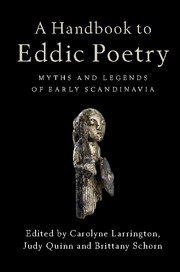Book contents
- Frontmatter
- Contents
- List of illustrations
- List of contributors
- Translations and abbreviations of the titles of eddic poems
- Introduction
- 1 The transmission and preservation of eddic poetry
- 2 Traditions of eddic scholarship
- 3 The editing of eddic poetry
- 4 The dating of eddic poetry
- 5 Eddic performance and eddic audiences
- 6 Eddic poetry and mythology
- 7 Eddic poetry and the religion of pre-Christian Scandinavia
- 8 Eddic poetry and heroic legend
- 9 Place names in eddic poetry
- 10 Eddic poetry and the imagery of stone monuments
- 11 Eddic poetry and archaeology
- 12 Eddic modes and genres
- 13 Eddic metres
- 14 Eddic style
- 15 Kennings and other forms of figurative language in eddic poetry
- 16 Alliterative lexical collocations in eddic poetry
- 17 The representation of gender in eddic poetry
- 18 The reception of eddic poetry
- Consolidated bibliography
- Index
9 - Place names in eddic poetry
Published online by Cambridge University Press: 05 August 2016
- Frontmatter
- Contents
- List of illustrations
- List of contributors
- Translations and abbreviations of the titles of eddic poems
- Introduction
- 1 The transmission and preservation of eddic poetry
- 2 Traditions of eddic scholarship
- 3 The editing of eddic poetry
- 4 The dating of eddic poetry
- 5 Eddic performance and eddic audiences
- 6 Eddic poetry and mythology
- 7 Eddic poetry and the religion of pre-Christian Scandinavia
- 8 Eddic poetry and heroic legend
- 9 Place names in eddic poetry
- 10 Eddic poetry and the imagery of stone monuments
- 11 Eddic poetry and archaeology
- 12 Eddic modes and genres
- 13 Eddic metres
- 14 Eddic style
- 15 Kennings and other forms of figurative language in eddic poetry
- 16 Alliterative lexical collocations in eddic poetry
- 17 The representation of gender in eddic poetry
- 18 The reception of eddic poetry
- Consolidated bibliography
- Index
Summary
There have been few analyses of place-name usage in Old Norse poetry. We have the odd article discussing names in poems such as Ynglingatal (e.g. Noreen 1925; Åkerlund 1939; Vikstrand 2004) and, of course, the related Old English Beowulf and Widsið. There are many cases where single names found in eddic poetry have been commented on and etymologised, but no one has, to our knowledge, taken a holistic approach to this material. The personal names of gods, goddesses, giants, dvergar (‘dwarfs’), etc. in the poems have attracted more interest (for an overview, see Mundal 1990). Our aims in this chapter are: first, to outline some of the material; second, to probe the meaning of the names (hence their etymology); and third, to see if there are any noticeable tendencies indicative of toponymic ‘genres’, especially between the mythological and the heroic poems. It is impossible to cover all the place names mentioned in the Codex Regius here; therefore, we concentrate on three of the most important poems for mythological place names – Vǫluspá, Vafþrúðnismál, and Grímnismál – taking them as samples which may enable us to draw some conclusions. One would expect the mythological poems to contain descriptive, fictional names, enhancing the mythic story, while in the heroic poems more ‘real-world’ place names might be expected, employed to situate the heroes within a European heroic past. The skaldic poems, in particular Ynglingatal, have many more place names; these add plausibility to the historical claims made in the poems, although the geographical designations may or may not be historically valid.
Names comprise an important element of frœði, or mythological knowledge. Take Vafþrúðnismál, a contest of frœði, for instance. The wisest of all giants asks his unknown interlocutor for four names: two personal names and two place names, and when he answers all four correctly, Vafþrúðnir admits: fróðr ertu nú, gestr (Vm 19/1) (‘wise you are now, guest’). Óðinn, on the other hand, asks for narratives instead: the origin of the cosmos, of earth, day, the seasons, and so forth, and then finally the details of ragnarǫk. In some cases the answers are little more than personal names, such as Vindsvalr, Svásuðr, or Hræsvelgr, but some of the narratives require toponyms.
- Type
- Chapter
- Information
- A Handbook to Eddic PoetryMyths and Legends of Early Scandinavia, pp. 173 - 189Publisher: Cambridge University PressPrint publication year: 2016
- 1
- Cited by

